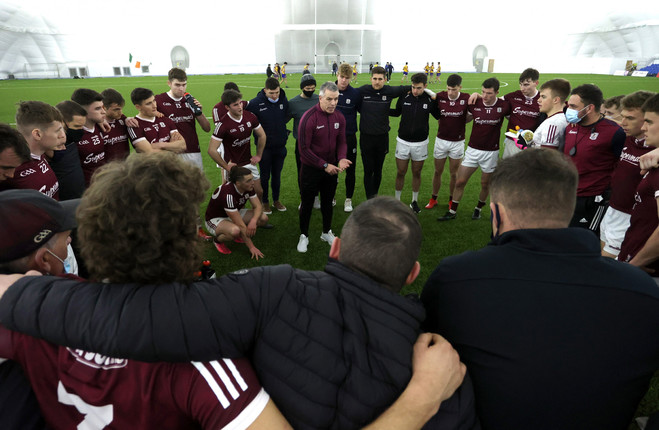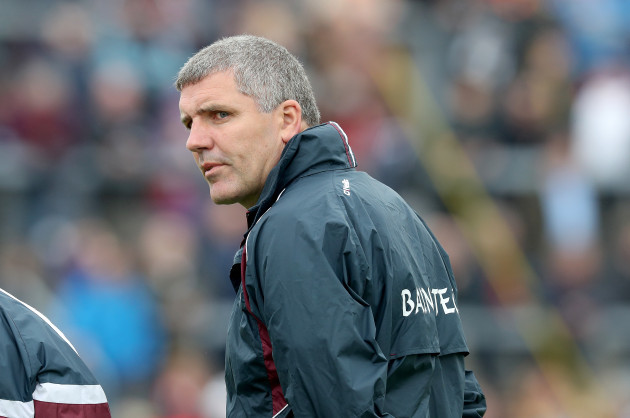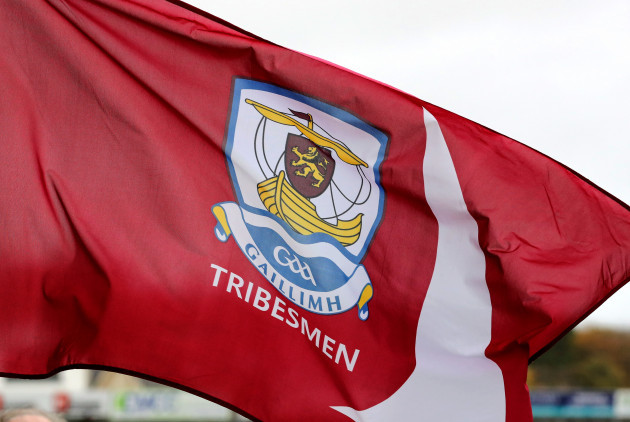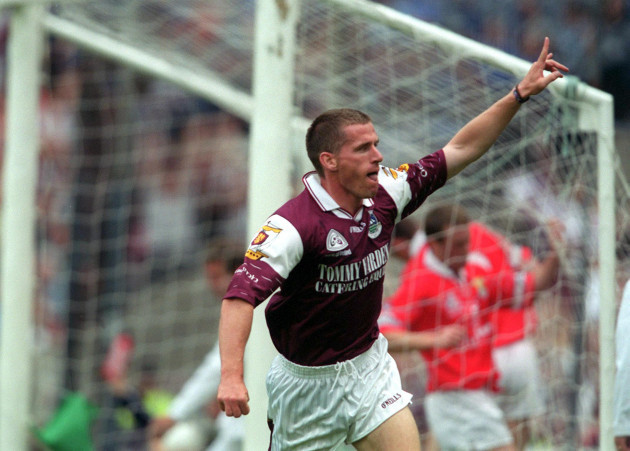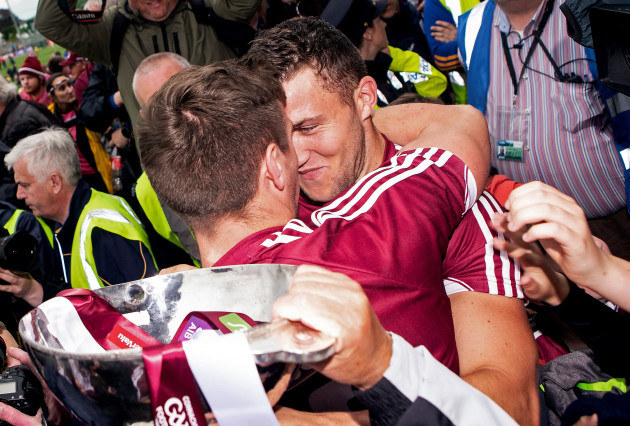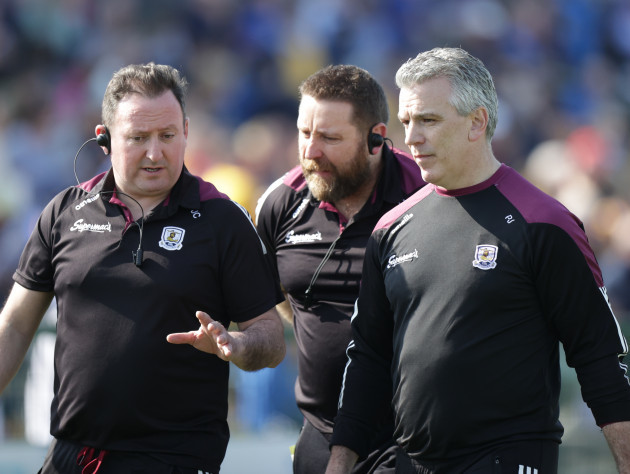THE FIGHT BEGAN after the final bell. It was 2017 and Galway had just capitulated to a nine-point Connacht Final loss in their own backyard.
As Kevin Walsh walked across the pitch in Pearse Stadium, he suddenly had to steer clear of more than just the invading Rossie supporters. First, he spotted goalkeeper Ruari Lavelle leaving the field with tears in his eyes. Then he found out why.
Eyes-bulging, finger cocked, a raging native reared up and let loose: ‘Get Lavelle out of goal… the Connemara bollocks. And all the rest of the Westies. Get them out to fuck!’
His club-rivalry fuelled tirade continued as Walsh and his teenage son stood in the firing line. Eventually, the Galway manager bit back. The pair had to be pulled apart.
In his five-year term, Walsh brought Galway back to Division 1, secured two provisional titles and an All-Ireland semi-final slot.
Unquestionably, he left the team in a better place. Still, he faced criticism within and outside the county. Not just about who he picked, but how they played. It was deemed outside the confines of the Galway way.
“One thing that always impressed me about Galway teams, the better Galway teams, was the style they played with. There was always a certain style. A bit of culture about it,” said Dublin’s Kevin Heffernan in the Tommy Varden History of Galway Football documentary.
Galway’s inheritance is a storied past that feeds their future vision. A particular iconography of Gaelic football. Herein lies the irony. The same characteristics that define success are evident in their failures. Making them and breaking them. The expectation. The romanticised style. The club rivalry. The self-assurance. A blessing and a curse.
“Kevin Walsh was accused of being too defensive. Then again, Pádraic Joyce is now seen maybe as too attacking,” says All-Ireland winning manager John O’Mahony.
He remains entrenched in the local scene, having recently taken charge of the Salthill Knocknacarra senior team.
“Perception? Those kinds of things were always thrown out. The history of Galway football, the tradition. It is the beautiful game.
“My view is that the challenge is to get the balance right. In ‘98 and 2001, we had that. Great forwards who could prevail in a shoot-out. If a team got a score against you, we could come back and get another score.
“But don’t forget we had brilliant defenders. All-Stars. I suppose the goal is more total football than all-out attack. When we lose the ball, everyone is a defender. When we have the ball, anyone can attack.”
Their All-Ireland tally has been stalled at nine since O’Mahony’s final triumph of 2001. The ghosts of that team and the 1998 iteration continue to linger over the current generation. Managed by Hall of Famer and one of their greatest ever scorers in Pádraic Joyce. 1998 star John Divilly is also on the ticket, as is the man who elevated their mythology with his unrivalled documentary. Pat Comer, of A Year ’til Sunday fame, is the current goalkeeper coach.
But that is not where the legend began. Far from it. It started at the very start. Eleven weeks before Michael Cusack outlined his plans for a new organisation at the Hayes Hotel, he spoke to a small gathering in Loughrea. Amongst the crowd was Michael Finnegan, a founding member of Dunmore McHales.
When they went to local bishop Patrick Duggan with the idea, he was supportive but had to decline an offer to become the patron of the GAA due to ill-health. In his place he suggested Thomas Croke, Archbishop of Cashel. Thus, they travelled to Thurles.
Unsurprisingly, Dunmore won the first county title. The game in North Galway began to boom, assured of their place in the association and its role in the country. Football was both a purpose and pursuit. It occupied long evenings and enlivened the routine of rural life.
The Tuam Krugers, named after the President of the Transvaal from the Boer War, represented Galway in the All-Ireland final of 1900. Despite the protestations of Kevin Walsh’s assailant, Galway’s strength has always come from its diverse catchment. Never has it solely mined one region. By 1913, the game had embedded in the east. Ballinasloe, backboned by the Egan brothers, won every county final from 1913 to 1929. A remarkable seven in a row. They progressed to power the senior team of 1919 too.
From that leapt one of the first local wonders. The famous man with the famous name. They still talk about ‘Knacker’ Walsh’s championship goal against Mayo in 1919. Attacking prowess was always cause for celebration.
Mick Donnellan came into that team, won an All-Ireland in 1925 and set a bar so high that when his son came after, he was told he’d never be as good as his father. John’s response was to captain Galway to Sam Maguire against Kerry in 1964. Meanwhile, the church of football continued to grow in Dunmore. When they contested the 1952 county final against Oughterard, it was filmed so the local cinema had something to fill the aisles.
Around the same time, the academy of St Jarlath’s was prospering in its first golden era. They contested the first-ever All-Ireland Colleges final in 1946 as champions of Connacht. That year, their famous son Seán Purcell, hailing from the shadows of the college, shone on the biggest stage. The Jarlath’s boys listened to the broadcast from the school hall. Tuam Town burned bright with bonfires on the Monday night as the Boys’ Band played their heroes home.
Even when the Catholic hierarchy deemed the All-Ireland series a distraction from study and it was abandoned in 1948, football continued to be practised in Jarlath’s. Their religion took priority.
Purcell became another icon as the lineage carried on. Each taking inspiration from what came before. Alongside Frank Stockwell, the ‘Terrible Twins’ terrorised full-back lines. Stockwell’s 2-5 from play in the 1956 All- Ireland win was another exploit that the next generation would be taught about. Learning. Yearning.
Every famed Galway side embodied the county. When the Galway City Museum revisited the three in a row team of 1964-66, Kilkerrin/Mountbellew clubman Christy Tyrell explained the success stemmed from their roots. They were a product of their environment.
The vast majority hailed from rural Ireland. None of them had cars, but a combination of bicycles and evenings spent on the bog footing turf kept them fit. It was hard to carry excess weight when you hadn’t much to eat. There was continuity and comradeship from minor up. Nine of the team that played together in 1964 were minors in 1959 and 1960. In 1965 their league success saw them take a trip to America. Two weeks of living together forged a bond. The 1963 All-Ireland final loss gave them experience and a hardened edge.
Climate and geography way west meant Connemara was never going to generate a production line of hurlers, but they too took massive strides in football. In 1996, An Cheathrú Rua became the first Gaeltacht team to win a county title. Westies like Kevin Walsh, Paul Clancy, Gary Fahey, Richie Fahey, Seán Óg De Paor and Seán Ó Domhnaill went on to lift Sam Maguire.
From fresh soil talent continued to spring. Two years later, Corofin became the first Galway club to win the All-Ireland. The brains behind their free-flowing, expansive style of football is the renowned Frank Morris.
When asked what prompted his culture change in that history documentary, he pointed to one crucial skill. A Galway speciality needed breeding.
“In the 1980s I was frustrated as a player. We didn’t have the players capable of taking the scores. We had plenty of backs and midfielders. Never forwards. Never players capable of taking scores like you need to do to win matches. I felt my biggest contribution, my best contribution, would be to start with young players and coach basic skills. One of the key skills is the ability to score.”
By the time O’Mahony assumed the mantle, he knew all about the perception and pride. Then he took a closer look at their silverware. For all the peaks, there were some deep troughs.
“I was old enough to remember the three in a row team. Just as Down did in the north and Kerry did, that team lead the evolution of football. Down in the early 60s, Galway’s three in a row. They played a great combination game. A wonderful style. I was very conscious of that. Galway had a fine brand of football.
“The thing is, I couldn’t believe it when I checked in 1998. They had won only one Connacht title in 10 years. From 1972 until 2002, they had no U21 title. Until 2007 when Paul Conroy was captain, they had no minor title in 31 years but came close a few times. There wasn’t always consistency. ”
In 2008 when Liam Sammon retired from his teaching job at St Mary’s College, he decided to write his second book on Gaelic football coaching. In the midst of writing that, he was appointed senior manager, succeeding Peter Forde.
That blueprint preached about the importance of the kick pass. He promised all training would involve a ball. They succeeded in Connacht and lost out in a quarter-final shoot-out with Kerry.
Joe Kernan came and went. Another band of former greats took charge. Alan Mulholland with selectors Paul Clancy and Declan Meehan. Their clay was a young squad with severe defensive frailties. Moulding a mean core proved unmanageable. 2013 kicked off with a 17-point loss against Mayo. It finished in 2015 with a 10-point beating at the hands of Donegal.
Paul Conroy, Shane Walsh and Damien Comer all played in Croke Park that day. Stuck in familiar mud. The same shades of attacking flair, the same flaws, the same outcomes.
Striving to emulate their own heroes. Walsh watched the History of Galway Football video daily after school. The Clonberne craftsman looked the part, ready to succeed former idols.
As a four-year-old, Comer stormed the pitch in the middle of a Glenamaddy club championship match in search of his father for a kickabout. Always enthusiastic, never a natural. His rise was less conventional. He failed to make the panel for the Jarlath’s Hogan Cup team and didn’t make the grade as a Galway minor either. He continued to strive, transforming his body and honing his skills.
For all the artistry of Walsh, Galway had to marry it with the hard-nosed cut of a Comer. Kevin Walsh would make him his captain.
Walsh recognised the folly of walking forward while constantly looking over your shoulder. To progress, they needed to build from the ground up.
“Kevin implemented a defensive arch,” recalls David Wynne. The Moycullen defender was called into the panel in 2016 and became a championship regular.
“It was a basketball setup. We progressed it nearly week on week but if you look at it holistically, we got better at dropping our wing-backs in and trying to get out after it.
“We probably didn’t see it all the way through and turn it into the threat it could be. It was trending that way. Players knew exactly what we were doing. Everyone knew. I probably wasn’t a corner-back really, but I understood what I was supposed to do and played to the system.”
Squad turnover was always an issue. Still is. In 2016 Wynne started as Galway shocked Mayo in Castlebar. For all their change, seven of that Mayo side will line out on Sunday. That figure would be higher if Rob Hennelly and Paddy Durcan were fit.
Four remain from Galway. Walsh had his trench warriors. Joyce brought with him a golden crop of U20 All-Ireland winners. Grand change.
“You really need to be adding on every year,” argues Wynne.
“Tweaking. Add five or ten percent. Not rip it down and start again. That is what holds Galway back. Not going well, start again.
“To be honest, it is about giving lads time. This thing of four years of strength and conditioning work, then lose them or drop them. Every time you do that, you have to start fresh. You are starting at the bottom. Mayo start a lad at a programme and see it through to 31. They are one of the most athletic teams we’ve seen. The turnover, if you are losing lads, even just a squad player, it is really hard to replace that.”
Internally there are always battles. In his autobiography, Walsh outlined his grievances around annual report recommendations that were not adopted by the county board, ranging from coaching to finance and medical.
What of the politics? The former Galway boss was often quizzed on some absentees from the great Corofin contingent. For Wynne, the national perception does not always reflect local realities.
“The view the public have is different to what happens on the ground. When you get lads into a squad of 30, the cream will rise to the top. If it is Corofin or Moycullen lads, whoever. Once they get in there, if they are not playing, they probably don’t deserve to be playing.
“The rise in the level of intensity is nearly like a different sport from club to inter-county.
“You see Corofin or whoever on TV, but you are not seeing the midfielder from the Aran Islands. When you are out on the pitch in Loughgeorge on a freezing evening, that is the lad who could be driving the sessions. Bursting lads and driving it on.
“The level of coaching and detail Kevin Walsh brought, I still see it in the boys who were involved in his squad. They still use footwork, the way they defend, showing people the line.
“In 2020 we won a county final with Moycullen. Myself and Brads (Gareth Bradshaw) took 80% of Kevin Walsh’s stuff and drove it into our boys. How to set up and defend. It gets overlooked. Kevin had all that work before Paddy Tally. That was really only the cherry on top.”
Joyce also has to contend with some castaways and absentees. Corofin’s Ian Burke withdrew after the 2020 Connacht final. Fiontán Ó Curraoin also departed, as did Wynne. Peter Cooke returned but elected to go travelling earlier this year.
In their relegation decider of 2021 against Monaghan, lively forward Eamonn Brannigan cut a displeased figure when he was taken off before half-time, despite having scored. He played in all three wins over Mayo from 2016-2018, notching 0-4. Brannigan came on in the final ten minutes of last year’s Connacht final loss and is not involved in the panel this year.
Elsewhere, the addition of Cian O’Neill’s tactical acumen has been well-received. As has the sessions with former Dublin sports Performance and Lifestyle coach and boxer Bernard Dunne. NUIG’s Sigerson conquest was charged by current Galway stars. The club championship has witnessed three different winners in three years.
At minor level, they reached All-Ireland finals in 2016, 2018 and 2019. They won the U20 Connacht championship in 2019, and in 2020 won an All-Ireland.
That is the county in a nutshell. With potential comes pressure. A sleeping giant? John O’Mahony is convinced Galway is a powder keg. Victory against Mayo can be the match.
“There is no real reason why Galway couldn’t have stayed at the top table more than they have in the past. It is all there. If Galway overcome this game, it could herald a new era.”
